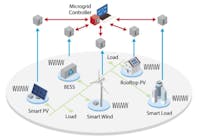AMI Project Advances to Full Implementation
The Department of Public Utilities (DPU) has served the City of Orangeburg, South Carolina, U.S., and surrounding community for more than 100 years, striving to provide customers with reliable and low-cost utility services. In 2010, DPU realized metering technology was available to improve the services (electric, water, gas and waste water) it provides to both its city and rural customers. After researching options and reviewing the current metering technologies, the utility decided to modernize its metering infrastructure and systems by implementing an advanced metering infrastructure (AMI) system.
Implementation of the AMI infrastructure and a meter data management system (MDMS), along with the related business process changes, improve overall customer satisfaction and increase operational efficiency. The goal was to provide customers with tools to view their bills and usage data, enabling informed decisions about the amount of services they use and related cost of services.
The AMI/MDMS plays a critical role in increasing operational automation and equipping DPU with tools to deliver services more reliably and efficiently. The capabilities from the system help to increase the level of customer service. Faster outage-response times, improved responses to customer inquiries, and remote disconnections and reconnections of electrical service were some of the anticipated benefits. Once fully deployed, DPU also plans to implement a prepay solution to provide DPU customers with an additional payment option.
The overall goal of the AMI/MDM project was to increase DPU’s customer satisfaction by maintaining affordable utility rates in the future and improving water, gas and electric distribution system reliability. Fundamental to improving customer satisfaction was empowering customers to control their utility usage and better manage their bills. Additionally, the project team focused on a list of 11 business objectives:
- Reduce meter service expenditures for operational divisions by 25%
- Reduce average call times by 25%
- Reduce hold times by 35%
- Reduce customer service operational expenses by 30%
- Reduce call volume by 20%
- Reduce reconnect time by 95%
- Reduce disconnect/reconnect truck rolls by 98%
- Reduce number of billing disputes by 40%
- Reduce electric outage time by 25%
- Reduce electric outage response time by 20%
- Increase water and waste water revenue by 5%
Pilot Implementation
DPU chose to develop the AMI project with a phased approach. Working with consulting firm UtiliWorks, DPU decided to start with a pilot project before proceeding to the full deployment. During the pilot phase, DPU was able to implement, configure and test the AMI, MDMS and interfaces with the legacy customer information system (CIS), geographic information system (GIS) and outage management system (OMS), and redesign the associated business processes. Interfacing the legacy CIS was a major challenge during the pilot because the original vendor no longer supported the CIS product. Staff developed the CIS side of the interface with the MDMS.
The pilot served multiple purposes:
- Creation of a development environment for adding and testing new functionality and configurations
- System training and business process redesign for the various operating groups within DPU
- System-acceptance testing and user-acceptance testing prior to a full-scale rollout to mitigate risks for all project stakeholders.
The AMI/MDM project was significantly complex because of the system integration, alteration of business processes and implementation of new applications. DPU was involved in all aspects of the decision-making and implementation processes. DPU employees were embedded in the project to ensure the utility had full ownership of the systems and would be able to leverage all of the system capabilities.
The choice for the AMI was Sensus’ FlexNet, which uses a point-to-point radio-frequency network as its foundation. Harris’ SmartWorks MDMS was chosen to help the utility make stronger analytical decisions and improve customer service. Harris’ CustomerConnect, a customer engagement solution, was selected to give customers direct, web-based access to granular usage data.
The AMI implementation project was led by a seven-person core DPU project team, but supported by resources from every area of the DPU operation (customer services, billing, IT, meter operations and management). UtiliWorks provided project oversight, project management and coordination, and technical consulting. The vendors supported the project with project managers, business analysts and technical analysts.
Prior to implementing the pilot project, DPU created a series of project assumptions:
- An initial phase of a small number of meter replacements will be conducted to verify system and infrastructure integration. This approach also will allow business process changes to be developed ahead of full implementation.
- 100% of electric meters will be changed out over the life of the project. The residential meters will require remote disconnect and connect capability. Meter change-outs for the initial phase will be done using DPU resources.
- A third party will be needed to change out the bulk of the electric meters.
- DPU’s existing fiber backhaul network was sufficient for the AMI implementation.
- DPU will add a communications module to the gas meters, leaving the existing gas meters in place.
- The level of effort required to specify, purchase, install, integrate, test and deploy the systems and equipment for AMI will exceed the resources available at DPU.
Phase-by-Phase Process
To ensure the project was implemented in a timely and comprehensive fashion, the project plan was developed to address the pilot in multiple phases. The alpha phase was designed to integrate the desired systems by installing and configuring the application systems, accompanied by a small meter population of electric, gas and water meters, which provided meter data and events for testing. During the alpha phase, the objective was to integrate the primary systems (AMI, MDM and CIS) to achieve a basic data collection and billing interface.
A beta phase was then undertaken by installing the AMI and a larger population of 1,100 electric meters, 150 gas module retrofits and 550 water meters. DPU contracted with Utility Partners of America to manage the meter installation process, with DPU staff performing the pilot meter installations. During the beta phase, communication with the meters was verified, meter data received was validated, meter events and alarms were processed, billing reads were compared, and the interface was verified to pass the billing reads to the CIS for customer billing. Business processes were developed and refined during the beta phase.
Weekly meetings were held with DPU project leadership, consultants and vendor project teams to provide project updates, address issues and ensure project continuity. As issues presented themselves in the project, the focus was on teamwork between parties to bring outstanding items to a close. Additionally, biweekly status review meetings were held with the project managers from DPU, UtiliWorks and the AMI/MDM vendor systems. DPU established a steering committee, consisting of directors from each operational division in DPU, for communication of the project status and to gain directional input.
Tracking and Scheduling
Project issues and risks were tracked and addressed on a biweekly basis, as well as by the steering committee as needed. The main risks identified for the project were the interfacing with the legacy CIS and the performance of the electric meters. DPU was able to make the CIS modifications using existing staff and by employing the services of a consultant who had expertise with the legacy CIS. DPU chose to implement electric meters from two different manufacturers during the pilot to verify meter performance in the field and with the AMI systems.
DPU specified industry-standard interfaces be used, where possible, to perform functionalities defined in the requirements of the project. Using MultiSpeak for interfaces expedited integration efforts. Additionally, the project decision-making process and structure was established in advance of initiating the AMI implementation project. The streamlined decision-making process proved valuable in keeping the pilot phase of the project on track.
The AMI implementation project consisted of two discrete procurements: the procurement and implementation of the MDMS, and the procurement and implementation of an AMI system, including both the retrofitting of old meters and the acquisition of new meters.
The project schedule had a completion target of the end of 2014. The schedule was monitored closely throughout the requirements, design and pilot implementation phases. The pilot phase was successfully completed in the fourth quarter of 2013, as projected. As a result, DPU was able to make a decision to move forward with the full deployment.
Time and Resource Management
Through this project DPU implemented several remote action functionalities that have reduced the number of field visits. The remote actions include remote meter readings, remote electric meter disconnections and connections, and remote demand resets for demand meters. Additionally, DPU chose to take advantage of the meter capability to limit current for customers who are somewhat unreliable with their payments but need electricity for medical and other purposes. By not completely disconnecting electric services, DPU increases positive customer perception of the utility and continues to protect its revenue.
Furthermore, DPU has been able to avoid many truck rolls through the use of remote actions, thus saving time and money for the utility and its customers.
The ease of interfacing the Data-Voice International OMS with the MDMS turned out to be painless for the utility. Integration of the OMS and MDMS provided benefits immediately by identifying specific premises that were experiencing outages. When outages occur, the event passes within seconds from the meter to the AMI head-end, to the MDMS and then to the OMS. The outage alert is made available to operations personnel before the customer has a chance to report the outage, enabling the utility to be proactive in responding to customers. This has assisted the utility in speeding up the outage-restoration process.
The mapping feature of the MDMS provides a high level of detail with various views from DPU’s GIS, Google Earth and other images. The multiple-view option assists the user in understanding the location’s geographic area as well as surrounding physical makeup.
Full Deployment in Sight
DPU staff received both administrative support and user training on the functionality of the AMI system and MDMS. In addition, the DPU meter service staff members have been trained on the AMI meter and module installation process and procedures. DPU chose to use its own staff to install the pilot meters so they would gain the knowledge and understanding of the AMI installation process.
DPU invested more than 1,000 hours in training for the AMI pilot implementation project. The DPU staff has spent more than 500 hours working on the development of new processes and procedures to effectively use the data and capabilities of the AMI implementation for the normal DPU operations and improved customer service.
DPU made a decision to implement a customer portal as part of the project. The customer portal was in the final stages of testing in January 2014 and it will be available for customer use by the time the full deployment of electric and gas is completed in the third quarter of 2014. The full deployment of water metering is planned to be rolled out in subsequent years based on budgetary constraints.
To stay current and take advantage of the latest technology, DPU made the decision to install the latest version of electric meters that became available in late 2013 for the full deployment. DPU also decided to upgrade the AMI by implementing the latest data collection devices available from the AMI vendor.
The DPU customer service team has embraced the AMI capabilities, including remote disconnect and reconnects. The customer service team is making requests for AMI meters to be installed on services when customers call in with issues ahead of the full meter deployment. The billing department has discovered the meter readings provided by the AMI system are far more accurate than the manual readings.
With the additional information provided by the AMI system and capabilities available with the MDMS, DPU will continue to identify opportunities and develop programs to further enhance efficiencies and benefits to customers and business operations. DPU maintains a continuous improvement approach to its operations and training to ensure the staff will take advantage of new capabilities.
Orangeburg DPU intends to use the AMI/MDM technology in its mission to provide customers with excellent service. Customers will have more information to control their usage and cost.
John Bagwell ([email protected]) is director of the city of Orangeburg’s Department of Public Utilities electric division and responsible for maintaining more than US$75 million in annual revenue while managing a staff of 50 dedicated employees. In this role, he has executed capital improvement plans in excess of $35 million as well as negotiated power supply contracts, which provide some of the lowest costs per residential kilowatt-hour in the Southeast. Bagwell started his more than 27 years of experience in the distribution and delivery of retail electricity as an electrical engineering graduate from Clemson University.
Carter Boling ([email protected]), a senior project manager with UtiliWorks, has extensive experience helping organizations meet the real-time technology challenges of today’s rapidly changing operational and business environments. He also provides consulting and implementation services to the electric utility industry. Areas of experience include smart grid/AMI/meter data management, energy management systems, SCADA and deregulation market systems.
Nicole Pennington ([email protected]) is a certified project manager and consultant for UtiliWorks Consulting, LLC. She is responsible for project management and assurance of client deliverables, and supports project activities by performing industry research, preparing critical documentation including in-depth reporting, and developing public relations campaigns for utility clients. Her responsibilities also include maximizing national media outlets, increasing sales activities and growing the overall communications channel.
Companies mentioned:
dataVoice International | www.datavoiceint.com
Orangeburg DPU | www.orbgdpu.com
Harris | www.harrisutilities.com
MultiSpeak | www.multispeak.org
Sensus | www.sensus.com
Utility Partners of America | www.utilitypartners.com
UtiliWorks | www.utiliworks.com





